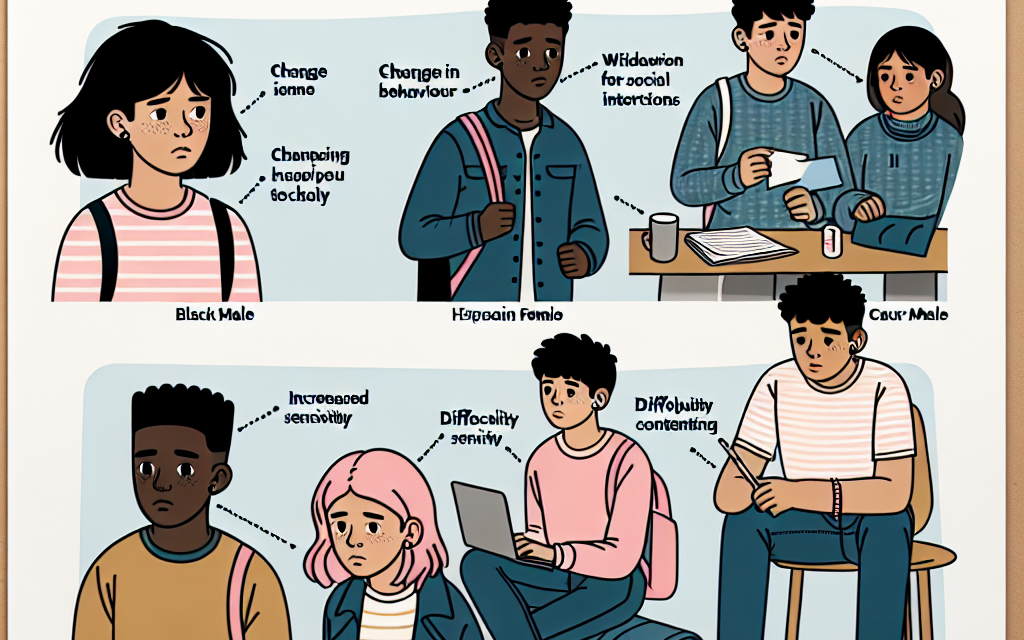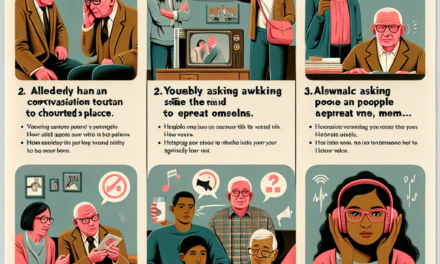Identifying Early Indicators of Mental Health Issues in Teenagers
The mental health of teenagers is a growing concern in today’s society. As adolescents navigate the complexities of growing up, they face numerous challenges that can impact their mental well-being. Identifying early indicators of mental health issues is crucial for timely intervention and support. This article explores the early signs of mental health issues in teenagers, the importance of awareness, and strategies for parents, educators, and peers to help those in need.
Understanding Adolescent Mental Health
Adolescence is a critical period for mental health development. According to the World Health Organization (WHO), half of all mental health conditions begin by age 14, but most cases go undetected and untreated. Understanding the unique challenges faced by teenagers is essential for recognizing early signs of mental health issues.
During adolescence, individuals experience significant physical, emotional, and social changes. These changes can lead to increased vulnerability to mental health issues such as anxiety, depression, and behavioral disorders. Factors contributing to mental health challenges in teenagers include:
- Biological Factors: Hormonal changes during puberty can affect mood and behavior.
- Environmental Influences: Family dynamics, peer pressure, and academic stress can contribute to mental health struggles.
- Social Media Impact: The pervasive use of social media can lead to feelings of inadequacy and anxiety.
- Trauma and Adversity: Experiences of trauma, abuse, or neglect can have lasting effects on mental health.
Recognizing these factors is the first step in identifying early indicators of mental health issues in teenagers. By understanding the context in which these issues arise, parents and educators can better support adolescents in their mental health journeys.
Common Early Indicators of Mental Health Issues
Identifying early indicators of mental health issues in teenagers can be challenging, as many symptoms may be mistaken for typical adolescent behavior. However, certain signs can serve as red flags for potential mental health concerns. These indicators can be categorized into emotional, behavioral, and physical symptoms.
Emotional Indicators
Emotional indicators are often the first signs that a teenager may be struggling with their mental health. These can include:
- Persistent Sadness: A teenager who exhibits prolonged feelings of sadness or hopelessness may be experiencing depression.
- Increased Irritability: Mood swings and irritability can indicate underlying anxiety or depression.
- Withdrawal from Activities: A loss of interest in previously enjoyed activities can signal emotional distress.
- Feelings of Worthlessness: Expressing feelings of inadequacy or self-doubt can be a sign of depression.
For example, a case study involving a 15-year-old girl named Sarah revealed that she had become increasingly withdrawn from her friends and family. Once an active participant in school clubs, she stopped attending meetings and began isolating herself in her room. Her parents noticed her persistent sadness and lack of motivation, prompting them to seek professional help.
Behavioral Indicators
Behavioral changes can also serve as early indicators of mental health issues. These may include:
- Changes in Academic Performance: A sudden decline in grades or lack of interest in schoolwork can indicate emotional distress.
- Risky Behaviors: Engaging in substance abuse, self-harm, or other risky behaviors can be a cry for help.
- Social Withdrawal: Avoiding friends and family or a change in social circles can signal mental health struggles.
- Changes in Sleep Patterns: Insomnia or excessive sleeping can be linked to anxiety and depression.
In another case, a 17-year-old boy named Jake began skipping school and engaging in risky behaviors, such as drinking alcohol and experimenting with drugs. His parents noticed these changes and sought help, ultimately discovering that Jake was struggling with anxiety and depression.
Physical Indicators
Physical symptoms can also manifest as indicators of mental health issues. These may include:
- Changes in Appetite: Significant weight loss or gain can be linked to emotional distress.
- Fatigue: Chronic fatigue or lack of energy can indicate underlying mental health issues.
- Physical Complaints: Frequent headaches, stomachaches, or other unexplained physical symptoms can be signs of anxiety or depression.
- Neglecting Personal Hygiene: A decline in self-care can indicate emotional struggles.
For instance, a 16-year-old girl named Emily began experiencing frequent headaches and stomachaches, which her parents initially attributed to stress. However, after further investigation, they discovered that Emily was struggling with anxiety and depression, leading to her physical symptoms.
The Role of Parents and Educators in Early Identification
Parents and educators play a crucial role in identifying early indicators of mental health issues in teenagers. Their awareness and proactive approach can make a significant difference in a teenager’s life. Here are some strategies for parents and educators to consider:
Open Communication
Establishing open lines of communication is essential for identifying mental health issues early. Parents and educators should create a safe space for teenagers to express their feelings and concerns. This can be achieved through:
- Active Listening: Show genuine interest in what teenagers have to say without judgment.
- Regular Check-Ins: Schedule regular conversations to discuss feelings, challenges, and successes.
- Encouraging Expression: Encourage teenagers to express their emotions through writing, art, or other creative outlets.
For example, a school counselor who regularly checks in with students can create an environment where teenagers feel comfortable discussing their mental health. This proactive approach can lead to early identification of issues and timely intervention.
Education and Awareness
Educating parents, educators, and teenagers about mental health is vital for early identification. Schools can implement programs that focus on mental health awareness, including:
- Workshops and Seminars: Host events that educate students and parents about mental health issues and early signs.
- Peer Support Programs: Train students to recognize signs of mental health issues in their peers and provide support.
- Resource Distribution: Provide information on local mental health resources and hotlines.
By fostering a culture of awareness and education, schools can empower students to seek help and support one another.
Encouraging Healthy Coping Mechanisms
Teaching teenagers healthy coping mechanisms is essential for managing stress and emotional challenges. Parents and educators can encourage the following strategies:
- Mindfulness and Meditation: Introduce mindfulness practices to help teenagers manage anxiety and stress.
- Physical Activity: Encourage regular exercise, which has been shown to improve mood and reduce anxiety.
- Healthy Social Connections: Promote positive friendships and social interactions to foster a sense of belonging.
For instance, a school that incorporates mindfulness practices into its curriculum can help students develop skills to manage their emotions effectively. This proactive approach can reduce the likelihood of mental health issues developing or worsening.
The Impact of Social Media on Teen Mental Health
In today’s digital age, social media plays a significant role in the lives of teenagers. While it can provide a platform for connection and self-expression, it can also contribute to mental health issues. Understanding the impact of social media on teen mental health is crucial for identifying early indicators of distress.
Comparison and Self-Esteem
Social media platforms often promote unrealistic standards of beauty, success, and happiness. Teenagers may compare themselves to these idealized images, leading to feelings of inadequacy and low self-esteem. Research has shown that:
- Increased Social Comparison: Teenagers who spend more time on social media are more likely to engage in social comparison, which can negatively impact self-esteem.
- Body Image Issues: Exposure to edited images can lead to body dissatisfaction and eating disorders.
- Fear of Missing Out (FOMO): Seeing friends engage in activities without them can lead to feelings of isolation and anxiety.
A study published in the journal “Cyberpsychology, Behavior, and Social Networking” found that higher social media use was associated with increased symptoms of depression and anxiety among teenagers. This highlights the need for parents and educators to monitor social media use and discuss its impact on mental health.
Cyberbullying and Its Consequences
Cyberbullying is another significant concern related to social media use. The anonymity of online interactions can lead to harmful behaviors that can have devastating effects on a teenager’s mental health. Key points include:
- Prevalence of Cyberbullying: According to the Cyberbullying Research Center, approximately 36% of students have experienced cyberbullying.
- Emotional Impact: Victims of cyberbullying are at a higher risk for depression, anxiety, and suicidal thoughts.
- Difficulty in Reporting: Many teenagers feel uncomfortable reporting cyberbullying due to fear of retaliation or not being taken seriously.
For example, a case involving a 14-year-old boy named Alex highlighted the severe impact of cyberbullying. After being targeted online, Alex experienced significant emotional distress, leading to anxiety and depression. His parents were unaware of the situation until it escalated, emphasizing the importance of open communication about online experiences.
Strategies for Healthy Social Media Use
To mitigate the negative impact of social media on mental health, parents and educators can implement strategies for healthy social media use:
- Setting Boundaries: Encourage teenagers to limit their social media use and take regular breaks.
- Promoting Positive Content: Encourage following accounts that promote positivity, self-acceptance, and mental health awareness.
- Discussing Online Behavior: Have open conversations about online interactions and the importance of treating others with respect.
By fostering a healthy relationship with social media, teenagers can enjoy its benefits while minimizing its potential harms.
Seeking Professional Help: When and How
Recognizing the early indicators of mental health issues is only the first step; knowing when and how to seek professional help is equally important. Parents, educators, and teenagers should be aware of the signs that indicate the need for professional intervention.
Recognizing the Need for Help
There are several signs that may indicate a teenager requires professional help, including:
- Persistent Symptoms: If emotional or behavioral symptoms persist for an extended period, it may be time to seek help.
- Impact on Daily Life: If mental health issues interfere with daily functioning, such as school performance or relationships, professional support is necessary.
- Self-Harm or Suicidal Thoughts: Any indication of self-harm or suicidal ideation should be taken seriously, and immediate help should be sought.
For instance, a 16-year-old girl named Mia exhibited signs of severe depression, including self-harm and suicidal thoughts. Her parents recognized the urgency of the situation and sought professional help, leading to a treatment plan that included therapy and medication.
Finding the Right Professional Support
When seeking professional help, it’s essential to find the right support for the teenager’s needs. Consider the following options:
- Therapists and Counselors: Licensed mental health professionals can provide therapy tailored to the teenager’s specific issues.
- Psychiatrists: For cases requiring medication, a psychiatrist can evaluate and prescribe appropriate treatment.
- Support Groups: Group therapy or support groups can provide a sense of community and shared experiences.
Parents should research potential professionals, read reviews, and consider recommendations from trusted sources. It’s also important to ensure that the chosen professional has experience working with adolescents.
Conclusion: The Importance of Early Intervention
Identifying early indicators of mental health issues in teenagers is crucial for promoting their well-being and ensuring they receive the support they need. By understanding the emotional, behavioral, and physical signs of distress, parents and educators can take proactive steps to help adolescents navigate their challenges.
Open communication, education, and awareness are essential components of early identification. Additionally, recognizing the impact of social media and knowing when to seek professional help can make a significant difference in a teenager’s mental health journey.
As a society, we must prioritize mental health awareness and support for teenagers. By fostering an environment that encourages open dialogue and understanding, we can help adolescents thrive and develop the resilience they need to face life’s challenges.
In summary, early intervention is key to addressing mental health issues in teenagers. By being vigilant and proactive, we can create a supportive network that empowers adolescents to seek help and lead fulfilling lives.





